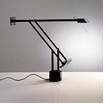Design Classics
Tizio Lamp, 1972
Designer: Richard Sapper
Manufacturer: Artemide

Born in Munich in 1932, Richard Sapper studied philosophy, engineering, anatomy and business management before turning to industrial design. He joined the design department at Mercedes-Benz, and in 1957 decamped to Milan where he worked for such design masters as Gio Ponti and as in-house designer for manufacturers and retailers. In 1981he became chief design honcho at IBM.
WHAT
The Tizio lamp strips the standard desk lamp down to its most basic form and function. Matte black and minimal in the original edition, it not only looks different but it works differently. Thanks to a transformer housed in the base, the light source is a low-voltage halogen bulb similar to those found in automobiles. The electrical current is conducted directly through the arms of the lamp, dispensing with the need for wires. Carefully balanced counterweights rather than tension springs allow you to change the position at the lightest touch and direct and keep light where it’s needed. One of my favourite positions is to bounce light off the ceiling. Sapper called the lamp Tizio – colloquial Italian for “guy.”
WHEN
In the early 1970s, Sapper approached Ernest Gismondi, one of the founders of Artemide, with a prototype made of iron discs, pieces of wood and a 12V car lamp. Perhaps because of its innovative technology and design, there were few buyers when it was introduced in 1972. Since then, more than two million have been sold.
WHY
Sapper’s vision was to create an adjustable glare-free lamp for “everyone’s daily existence.” The Tizio combines sophisticated German-influenced engineering with Italian flair – the linear matte-black elements are punctuated by jaunty red accents in the switch and the connectors. It was one of the first lamps to use low-voltage halogen, which has now become commonplace. It was a prestigious Compasso d’Oro award in 1989 and is part of the permanent collection of the Museum of Modern Art. More important, it’s probably on the desks of more designers and architects than any other object. Its simplicity and functionality make it the perfect light source to illuminate the latest technology or the most classic antique.
National Post, January 26, 2006
